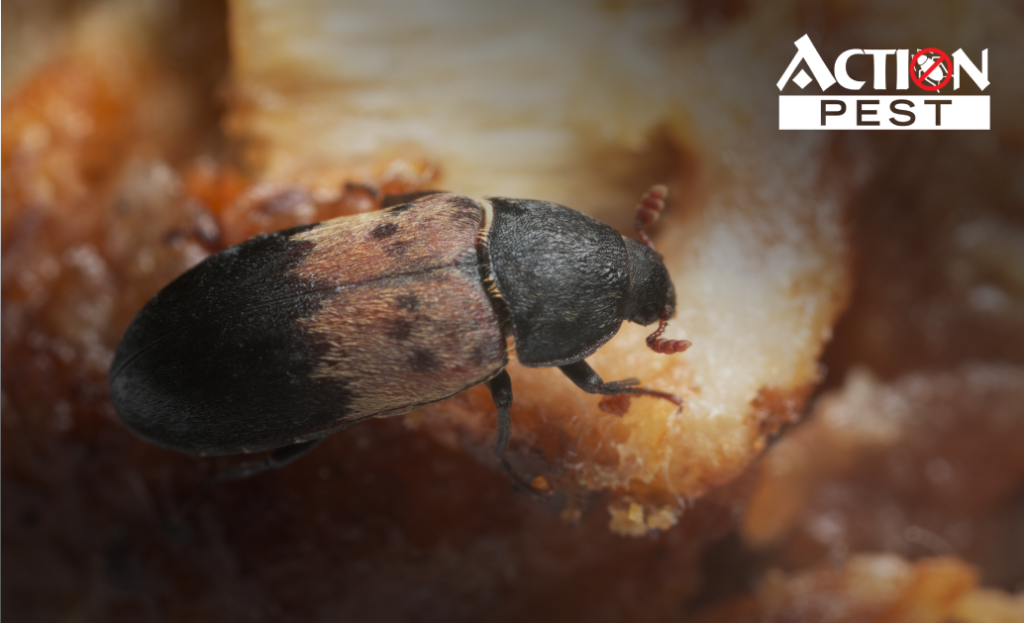
Have you ever opened a kitchen cupboard and grabbed a box of food, only to find it infested with small beetles? You’ve just come face to face with larder beetles, and it may not stop there.
While mainly found in kitchens and other places with an abundance of food sources, larder beetles can migrate to other parts of your home- even the bedroom! That’s bad news, especially if you’re one of the many people allergic to their shed skins. And even if you weren’t, the last thing you want is an infestation.
At Action Pest, we can help you eliminate these bugs from your home and prevent them from coming back. In this blog, we explain what a larder beetle is, how to spot an infestation, and how to keep them out once a professional pest control company has treated the property.
What is a Larder Beetle?
The larder beetle, or Dermestes lardarius, is an invasive insect in Canada. At around 1/4” long, they’re small and have a black or dark brown body with a tan middle and black dots. They’re often mistaken for cockroaches, which isn’t surprising given the similarities: both bugs regularly invade kitchens for food and water. With larder beetles, you’re more likely to find them in bags of flour and grains (e.g. rice) because the packages are easier to infiltrate, but they’ll happily eat anything, especially foods that are high in fat and protein.
While they’re not harmful to humans, larder beetle larvae and shed skins can cause some people to experience an allergic reaction, as we already mentioned. They can also contaminate food and, when they’re in the larva stage, tunnel through wood, soft metal, and mortar, compromising the structure of your home. That’s why you want to take steps to get rid of them as soon as you know you’ve got larder beetles in your house.
How Did I Get Larder Beetles?
Home invasions by larder beetles are most likely to occur in the spring and fall. When spring comes, they’re looking for the perfect place to lay their eggs, while in the fall, they’re attracted to the warmth of your house.
They often enter buildings through cracks, torn window screens, attics, fissures in walls, and other openings. Carry-bags, cardboard boxes, or food that has previously been contaminated can also bring them inside.
What Are The Signs Of a Larder Beetle Infestation?
In most cases, the first sign of an infestation is near food sources. You may find beetles (living and dead), shed skins, and banana-shaped egg clusters in your food containers, although they’ve also been known to nest behind stoves and electrical outlets as well as around electrical wires and piping. You might also want to check your attic: a sudden larder beetle infestation can also mean that you’ve got mice or other insects hiding in your home.
Why Are There Larder Beetles in My Bedroom?
Although larder beetles commonly feed on foods that are high in fat and protein, such as cooked meats, they’ll eat practically anything, even fabrics and natural materials. Bedrooms are not only a good source of these fabrics, but also dead skin cells and hair, which these beetles also relish.
How to Get Rid of Larder Beetles
Check for larder beetle infestations by buying sticky traps at the hardware store. After a week, if you find more than one beetle in your traps, you should call a 24-hour Hamilton exterminator, as these bugs can overrun your home very quickly.
During and after treatment, take these steps to prevent an infestation from spreading or recurring:
- Store pet food and staples in airtight containers and dispose of contaminated food in sealed bags.
Thoroughly vacuum all rooms to eliminate food sources like crumbs and suck up larvae. - Make sure you empty your recycling container every day.
- Get rid of grease by wiping down your stove and range hood.
- Make sure your attic air intake spots and soffits have mesh screens installed.
- Repair damaged window and door screens
- Fix cracks and openings in the house’s exterior walls.
- Inspect your attic, basement, and other areas of your home for dead insects or pests and remove them.
How Serious Are Larder Beetles?
Like we stated earlier, larder beetles are more of a nuisance than an actual health hazard, but their ability to contaminate food and even damage your home means that you want them out of your home as soon as possible.
At Action Pest Control, we have years of experience dealing with larder beetle infestations in homes and businesses. We use safe but effective methods that eliminate both larvae and adult insects without damaging your property or presenting a risk to children or pets. When you need thorough and affordable extermination services in and around Hamilton, Burlington, and Oakville, contact us. We offer 24-hour service, so we’re there when you need us.







